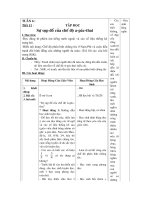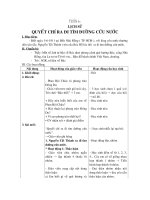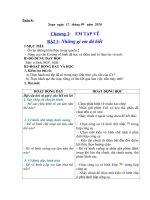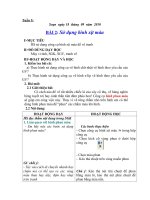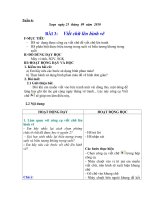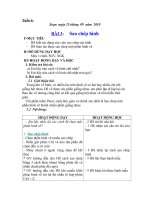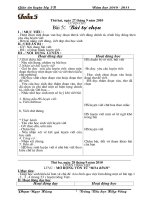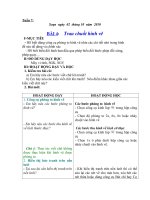giao an TA lop 5 tuan 6 10
Bạn đang xem bản rút gọn của tài liệu. Xem và tải ngay bản đầy đủ của tài liệu tại đây (172.29 KB, 28 trang )
<span class='text_page_counter'>(1)</span>Week 6: Monday, October 2 nd , 2017 Period 21 :. Review. ----------------------------------------------------------------------------------------------------. Unit 2: Let’s play after school ! Lesson One – Period 22 I/ Aims: - To understand a short story and present the vocabulary of after school activities II/ Language contents: 1.Structure: Can you play on …?, Let’s play after school., How about ..?,I … every Tuesday. 2.Vocabulary: help my mum, do my homework, visit my grandma, go swimming, have a music lesson, watch TV. III/ Teaching Aids: CD track 15-17, Flashcards – After-school activities 11-20 - PMB p.8 IV/ Steps of teaching: 1.Warm up and reviews: - Word Relay: Review days of the week. Choose 10 children to come to the board and stand in teams of 5 facing the board. Whisper a day of the week to the last child in the line. They whisper it to the next child and so on. The first child writes the word on the board. The first team to write it first and correctly gets a point. 2. Presentation: - Use flashcards 11-20 to introduce the key vocabulary. Hold up the flashcards and elicit the after-school activities from the children. Hold up each one in a different order and say the words for children to repeat..
<span class='text_page_counter'>(2)</span> 3. Practice: Listen , point and repeat. - Ask children to look at the pictures and play the first and second parts of the recording as children point to the words. Repeat and the children to repeat the words after the audio. - Children work in group. Listen and chant. - Play the recording for children to listen to the chant. Play the chant a second time for children to say the words. 4. Production: - Play a game “Guess the word” V/ Extension: ........................................................................................................ -------------------------------------------------------------------------------------------------. Thursday, October 5 th , 2017 Unit 2: ( cont ) Lesson One – Period 23 I/ Aims: - To understand a short story and present the vocabulary of after school activities II/ Language contents: 1.Structure: Can you play on …?, Let’s play after school., How about ..?,I … every Tuesday. 2.Vocabulary: help my mum, do my homework, visit my grandma, go swimming, have a music lesson, watch TV. III/ Teaching Aids: CD track 15-17, Flashcards – After-school activities 11-20 - PMB p.8..
<span class='text_page_counter'>(3)</span> IV/ Steps of teaching: 1.Warm up and reviews: - Miming: Review after-school activities. Put the children in teams of 6. Ask one child from each team to come to you. Show a flashcard of an activity. The child goes back to their team and mimes the action- no speaking. The first team to guess gets a point. Repeat with different children. - Show the flashcards again one by one and say the words for the children to repeat. 2. Presentation: Listen and read - With books closed children listen to the story and shout the days of the week when they hear them. - Recording 17: Ask the children to open their books and tell you what they can see in the pictures in exercise 3. Listen to the track and point to the speech bubbles in the story as they hear the sentences. - Ask the children to read the story again and point to the words from exercise 1. 3. Practice: - Listen and do: With the children think of an action for each of the after school activities. Play recording 17 again and the children do the actions. 4. Production: - Jump: Play jump with the class with the flashcards. Hold up the flashcards one by one. If the word you say and the flashcard matches the children jump. If it doesn’t match the children shout out the correct word. V/ Extension: .........................................................................................................
<span class='text_page_counter'>(4)</span> Lesson Two – Period 24 I/ Aims: - Talking and reading about after school activities. II/ Language contents: 1.Structure: I visit my Grandma on …., I don’t watch TV., I go swimming on … 2.Vocabulary: help my mum, do my homework, visit my grandma, go swimming, have a music lesson, watch TV. III/ Teaching Aids: Flashcards 11-16, CD track 17, Grammar reference p.74, Unit 2. IV/ Steps of teaching: 1.Warm up and review: - Review after school activities. Play slowly reveal with the flashcards 11-16.Cover the front of each card as you show it and uncover slowly as the children guess what the activity is. 2. Presentation: Listen to the story again and repeat.Act - Ask the children some questions about the story from the last lesson. What does Alice do after school on Tuesday? Etc - Play track 17 and pause after each dialogue for the children to repeat. - Review the actions for the story from lesson 1. - Play the recording again and the children do the actions. - Put the children in groups of 4 and ask them to role play the story. Look and say - The children look at the pictures in ex 2 and ask them what they can see. - The children point to the pictures as you read the sentences..
<span class='text_page_counter'>(5)</span> - On the board write the sentences from exercise 2. Ask the children to repeat after you, whole class and individual children. - Rub out the activities in each sentence and show the flashcards and ask the children to repeat the sentences with the activity on the flashcard. Repeat a few times with different activities. 3. Practice: Write: Ask the children to look at the words and pictures in exercise 3 and do the first sentence as an example. The children do exercise 3. Point and say: Pair work: Asking and answering. Give and example of exercise with 2 children. The children do the exercise with their partner. 4. Production: Ask the children to do Unit 2 on p.74 Grammar reference. V/ Extension: ........................................................................................................ ----------------------------------------------------------------------------------------------------. Week 7 Monday, October 9 th , 2017 Lesson Two – Period 25 I/ Aims: - to practice word order and writing and describing after-school activities II/ Language contents: 1.Structure: I like, I don’t like… 2.Vocabulary: Zoo animals: elephant, giraffe, monkey. Descriptive adjectives: big, tall, little III/ Teaching Aids: Story Poster 2; Zoo flashcards 11-16; CD track 16 IV/ Steps of teaching:.
<span class='text_page_counter'>(6)</span> 1.Warm up and review: - Play Snap with the after -school activities flash cards. Show a flash card and say the activity. If it is the same the children say “SNAP” 2. Presentation and practice: - Put the following sentence on the board: Monday swimming on go I. don’t I homework do Sunday on my. Ask a child to come to the board and get the rest of the class to help them put the sentences in the correct order. - Ask the children what they can see in the pictures in exercise 1 on page 15 in their workbooks. - The children do exercise 1. Ask them to compare their answers with their partner before you feedback. - Reading and Writing: The children do exercise 2. - Speaking: Ask the children to work in pairs and name them A and B. Ask B to close their books. A has the book open and looks at the table in exercise 2. A says a sentence e.g. I visit my grandma on Tuesday and B has to say if it is true or false. Give an example, ask the children to close their books and tell you if the sentence you say is correct or not. After a few minutes ask the children to change roles. 4. Production: - Vocabulary review: play categories: Put the children in teams of 4. One child in the team is the writer. Tell them a category one at a time e.g. school subjects, after school activities, school rooms and areas, colours, things in the classroom. The teams have one minute to write as many things as they can remember for that category. The winning group has the most for each category. V/ Extension: .........................................................................................................
<span class='text_page_counter'>(7)</span> Lesson Three – Period 26 I/ Aims: Talking about after school activities Listening and speaking II/ Language contents: 1.Structure: After school 1 read/write/help play… 2.Vocabulary: listen to music, play with friends, read a book, write an email. III/ Teaching Aids: CD track 18,19, Flashcards - After-school activities 11-20 IV/ Steps of teaching: 1.Warm up and reviews: Review after school activities with flashcards 11-16. Play board slap. Ask 10 children to come to the board and make 2 lines in front of the board. Put the flashcards 11-16 on the board. Whisper one of the words to the last child in each line. They have to whisper the word to the child in front of them down the line. The child at the front has to slap the correct picture. The first team to slap the correct picture gets a point. Play a few times. 2. Presentation: - Show the children the flashcards of after-school activities 17-20 and elicit the vocabulary. - Show the flashcards one by one again and say the words and ask the children to repeat together and by themselves. 3. Practice: Listen, point and repeat. - Ask the children to look at the pictures in exercise 1 on page 16. Ask the children to listen and point to the pictures. -Ask the children to listen again and repeat. Listen and sing..
<span class='text_page_counter'>(8)</span> -With books closed children listen to the song and stand up when they hear an after school activity. - Ask the children to open their books on p16 and look at the pictures in ex.2. Ask them where the children are and what they are doing. Recording1 9: Play the song again twice, pausing for the children to repeat. -Play the song again for the children to sing along. Sing and do. Divide the class into 2 groups. One group sings the chorus and one group sings the verses. Ask the children to sing loudly and then softly. 4. Production: - Play slowly reveal with the flashcards 11-20. Cover the front of the flashcard with a piece of paper. Slowly move the paper down to show the picture to the children until they can guess what the picture is. V/ Extension: ........................................................................................................ ---------------------------------------------------------------------------------------------------. Thursday, October 12 th , 2017 Unit 2: ( cont ) Lesson Three – Period 27 I/ Aims: To practice writing verb noun collocation II/ Language contents: 1.Structure: After school 1 read/write/help play… 2.Vocabulary: listen to music, play with friends, read a book, write an email. III/ Teaching Aids: CD track 18,19, Flashcards - After-school activities 11-20 IV/ Steps of teaching: 1.Warm up and reviews:.
<span class='text_page_counter'>(9)</span> Give the children the extra activity work sheet for the song and then sing the song again for them to check their answers with or without track19. 2. Presentation and Practice: Review the after school activities with the flashcards 17–20, eliciting the words from the children. Ask the children to look at the pictures in exercise 1 on p.16 of the workbook. The children do exercise 1 on page 16 in their workbooks. The children do the first part of exercise 2 on page 16, completing the sentences in their workbooks. Tell the children to look at the picture in exercise 2 and point to the correct picture when you say a sentence e.g. I watch TV Pair work: The children take it in turns to say a sentence and their partner points to the correct picture. The children do exercise 2 on page 16 in their workbooks, numbering the pictures. 4. Production: - Play slowly reveal with the flashcards 11-20. Cover the front of the flashcard with a piece of paper. Slowly move the paper down to show the picture to the children until they can guess what the picture is. Listening and Speaking: Play Pass the Flashcards. Give a flashcard to a child at the front and say the activity e.g. I watch TV. They repeat the phrase and pass it to the next child who says the phrase and passes it on around the class. Give out another to a child at the back and repeat the procedure. Give out the rest to children in different places in the room until you have a chain of 10 cards going around the room. V/ Extension: .........................................................................................................
<span class='text_page_counter'>(10)</span> Lesson Four – Period 28 I/ Aims: - Phonics consonant blends practice. Speaking and listening skills II/ Language contents: 1. Structure: 2.Vocabulary: flower, flat, plum, plate, blanket, blue. III/ Teaching Aids:CD track 20, 21, 22 - Flashcards – After-school activities 11-20. IV/ Steps of teaching: 1.Warm up and review: Play Quick Flash with flashcards 11- 20. Show each flashcard in turn very quickly and the children shout out what it is. 2. Presentation: Listen, point and repeat - Hold up the phonics cards 4-6 one at a time and say the sound e.g. fl. Drill each sound with whole class and individuals. -Hold the cards up again and say the words e.g. flower children repeat -Ask the children to open their student books on p.17 and look at the pictures in exercise 1.The children listen and point at the pictures. Listen and chant - The children look at the picture in exercise 2 and tell you what they can see. Play the chant and ask the children to put up their hands when they hear any of the words from exercise 1..
<span class='text_page_counter'>(11)</span> - Play the chant again pausing after each line and ask the children to repeat. Repeat again. - Play the chant the whole way through and the children follow in their books. Repeat and the children say the chant with the recording. 3. Practice: Read the chant again.Circle the sounds “ fl/ pl/ bl. On the board write plums on a plate. Ask a child to come to the board and circle pl in the words. Ask the children to do exercise 3, circling the sounds. Listen and complete the words. The children look at the pictures in exercise 4 and tell you what they see. The children do exercise 4. Play track 22 and the children listen and check their answers. 4. Production: Put the children in teams of 4. Tell them a sound e.g. pl and they have one minute to think of as many words as they can beginning with pl. V/ Extension: .........................................................................................................
<span class='text_page_counter'>(12)</span> Week 8 Monday, October 16 th , 2017 Unit 2: ( cont ) Lesson Four – Period 29 I/ Aims: - Phonics consonant blends practice. Speaking and writing skills II/ Language contents: 1. Structure: 2.Vocabulary: flower, flat, plum, plate, blanket, blue. III/ Teaching Aids:CD track 20, 21, 22 - Flashcards – After-school activities 11-20. IV/ Steps of teaching: 1.Warm up and review: - Give each child an extra practical classroom activity worksheet. Dictate the key vocabulary words. The children listen and write them in the correct box. Feed back with the whole class. 2. Presentation and Practice: Show the phonics cards 4-6, but cover the words and pictures so the children only see the sound. Elicit the words for each sound e.g. fl – flower flat Ask the children to open their workbooks on p.17 and say the sounds in exercise 1. Ask them to do exercise 1. Ask the children to look at the pictures in exercise 2 and tell you what they see. The children do exercise 2..
<span class='text_page_counter'>(13)</span> Ask the children if they can remember the chant from the previous class. Tell them the first line and elicit the other lines. The children do exercise 3 writing in the missing words to the chant. Recording 21: play the chant for the children to check their answers. 4. Production: Writing and speaking: Put the following words on the board: flower, flat, plum plate, blanket, blue, drum, dress, truck, tree, crayon, crab Ask the children to help you make a rhyme with at least 3 of the words e.g. The flat flower is blue and on the blanket. Ask the children to work with a partner and write a rhyme like the one on the board using as many words as possible from the list. Get the children to read their rhymes to the class. V/ Extension: ........................................................................................................ --------------------------------------------------------------------------------------------------Lesson Five – Period 30 I/ Aims:. Reading - speaking. II/ Language contents: 1.Structure: 2.Vocabulary: do, go ,play ,watch ,listen, draw, paint, write ,skate, help, swimming III/ Teaching Aids: - CD track 23 IV/ Steps of teaching: 1.Warm up and reviews: - Sing the song “After school” from p.16. 2. Presentation: Look at the pictures. Say what the children do. - Ask different children what they do after school..
<span class='text_page_counter'>(14)</span> - Ask the children to open their books at p.18 and look at the pictures of the children. Ask them to tell you what the children do after school and which words they think they will read in the text e.g. football. Write their answers on the board. 3. Practice: Listen and read. - Ask the children to listen to the track and read and then tell you which words on the board are in the text. - Play the track again and ask the children some questions e.g. “Does Max help his mum after school?” “Who listens to music?” - In pairs the children take it in turns to point to a picture and their partner tells them what the child does after school. Read again. Who does each activity? - Ask the children to look at exercise 3. Ask them to point to where they see the word park in the text. Ask them Who goes to the park? Show them the answer M in exercise 3. Ask the children to find the word stories and ask Who writes stories? Ask them to write the letter J for answer 2. The children continue exercise 3 individually. - Ask the children to check their answers with their partner. 4. Production: - Speaking: Ask the children to close their books and work in teams and play a memory game. Ask the teams, in turn, questions about the text e.g. Who goes swimming? What does Max do? Ask each team a few questions and give points for the correct answer. V/ Extension: .........................................................................................................
<span class='text_page_counter'>(15)</span> Thursday, October 19 th , 2017 Unit 2: ( cont ) Lesson Five – Period 31 I/ Aims: - Reading to writing and speaking II/ Language contents: 1.Structure: 2.Vocabulary: III/ Teaching Aids: Flashcards - After-school activities 11-20 IV/ Steps of teaching: 1.Warm up and reviews: - Review vocabulary from the last lesson. Ask 10 children to come to the board and put them in 2 lines facing the board. Show the first child in each line a flashcard and they run to the board and write the word. The first team to write it correctly gets a point. 2. Presentation and Practice: - Ask the children to look at the picture in exercise 1 on p.18 of the workbook and ask them to tell you what they see. - Ask the children to look at the text and circle the after-school activities they see. - Ask the children to look at exercise 2. Write I’m Tony on the board. Ask the children if this is correct? Circle Tony and write I’m Alex. - Ask the children to read the text again and do exercise 2. - Feedback asking individual children for the answers. - Give the children a copy of PMB p.9. Ask them questions about the table e.g. Does Pam help her mum on Thursday? The children do exercise 1..
<span class='text_page_counter'>(16)</span> - The children tickand cross x for me on the table. Then the children ask and answer What do you do at the weekend? with their partner. Give an example with 2 children across the class. 3. Production: - Pair work: - Speaking: Ask the children to work in pairs and name them A and B and ask them to sit back to back. Give A and B the correct part of the extra practical activity worksheet. A reads their text to B and B fills in the missing words and then they change. They check with each other to make sure the texts are the same. V/ Extension: ...................................................................................................... ------------------------------------------------------------------------------------------------. Lesson Six – Period 32 I/ Aims: - Listening to speaking to writing II/ Language contents: 1.Structure: I play/ride/listen to/do/visit skate/have…. 2.Vocabulary: read, ride, play, go swimming, write, have, skate, visit. III/ Teaching Aids: CD track 24, Flashcards - After-school activities 11-20 - Extra practical classroom activities – Spelling quiz. IV/ Steps of teaching: 1.Warm up and reviews: - Give out the flashcards 11-20 to 10 children. Ask the children around the class What do you do after school? The children with the flashcards listen for their activity and hold the flashcard up when they hear it..
<span class='text_page_counter'>(17)</span> 2. Presentation and practice: - Ask the children to open their books on p.19. - Ask the children to look at the pictures in exercise 1 on p.19. Ask the children questions about the pictures e.g. What can you see in picture 2? Listening: Listen and tick( )or ( ). - Play the recording and ask the children to listen and shout out when they hear and after-school activity. - Play the track again and stop after the first item and show the next to the book. Continue the track, pausing after each item for the children to the correct picture. - Play the track again for the children to check their answers. Speaking: Look and say. - Give an example with one child - prompt by saying number 1 and the child says I read a book. I don’t ride a bike. Give another example with number 2. Ask the children to work in pairs and continue. Writing: Circle the verbs. - The children do exercise 3. 3. Production: - Spelling quiz: Put the children into teams of 4. Give each team a hand out – the spelling quiz. Ask the children to choose a name for their team and write it on the top of the hand out. Read out the words one by one from page 2 and the teams have to spell the words correctly on their hand out. Teams change hand outs and check each other’s spelling as you write them on the board.. Week 9.
<span class='text_page_counter'>(18)</span> Monday, October 23 th , 2017 Lesson Six – Period 33 I/ Aims: - Writing II/ Language contents: 1.Structure: We watch/play/ listen …I watch/listen/play …I don’t listen/play/ watch… 2.Vocabulary: Visit, play, help, have, watch, do, listen, read, write III/ Teaching Aids: - PMB p.7 Values worksheet, Flashcards - School subjects and school rooms 1-10. IV/ Steps of teaching: 1.Warm up and reviews: - Give the children the extra practical activity board game – After school and get them to play in teams of 4. 2. Presentation and Practice: - Write the following sentence on the board: I visit my cousins. Ask a child to come to the board and circle the verb. - The children do exercise 1 on p.19. - Children compare their sentences. - Ask the children what they do after school… - The children do exercise 2. - On the board put 2 flashcards, one with aand one with a x. Ask a child to come and write a sentence for the ticked picture e.g. I write emails and choose another child to write the negative sentence I don’t ride a bicycle. The children do exercise 3 – draw pictures and write sentences. 3. Production:.
<span class='text_page_counter'>(19)</span> - Identifying values: Write Helping people on the board. Ask the children what they do help their family and friends and write their answers on the board e.g. I help my mum cook. - Give the children a copy of p.7 of PMB. Ask them what they can see in the pictures. Make sure they see the names on the children’s t shirts. Ask them who is helping and who isn’t. - The children do exercise 1. Feedback whole class. - Writing: The children do exercise 2. Draw pictures and write about what they do to help. Ask a few children to tell the class for feedback. V/ Extension: ........................................................................................................ ---------------------------------------------------------------------------------------------------Period 34 :. Review.
<span class='text_page_counter'>(20)</span> Thursday, October 26 th , 2017 Unit 3: Let’s buy presents ! Lesson One – Period 35 I/ Aims: - To understand a short story and present the vocabulary of after party objects II/ Language contents: 1. Structure: What does he/she like?, He/ she likes…,I like these..., He /she doesn’t like .. 2.Vocabulary: chocolate, sweets, balloon, present, cake, card. III/ Teaching Aids: IV/ Steps of teaching: 1.Warm up and reviews: - Word Relay: Review verbs for after-school activities e.g. visit, help, play, have listen etc. Choose 10 children to come to the board and stand in teams of 5 facing the board. Whisper one of the verbs to the last child in the line. They whisper it to the next child and so on. The first child writes the word on the board. The first team to write it first and correctly gets a point. 2. Presentation: - Use flashcards 21-26 to introduce the key vocabulary. Hold up the flashcards and elicit the party objects from the children. Hold up each one in a different order and say the words for children to repeat. 3. Practice: Listen , point and repeat. - Ask children to look at the pictures and play the first and second parts of the recording as children point to the words. Repeat and the children repeat the words after the audio..
<span class='text_page_counter'>(21)</span> - Ask the children to listen and repeat. Hold the flashcards up as the words are said. - Children work in group. Listen and chant. - Play the recording for children to listen to the chant. They can clap the rhythm as they listen. Play the chant a second time for children to say the words. This time they can point to the correct flashcard as they hear the word. Repeat (more than once if necessary). Listen and read - With books closed children listen to the story and put up their hand when they hear a party object - Ask the children to open their books and tell you what they can see in the pictures in exercise 3. Listen to the track and point to the speech bubbles in the story as they hear the sentences. - Ask the children to read the story again and point to the words from exercise 1. The children repeat the dialogue after the CD. 4. Production: Speaking: Give the children a copy of PMB p.12. The children do exercise 1completing the faces for what they like and don’t like. Ask a couple of children to tell you what they like and don’t like. In pairs the children tell each other using p12 as an example ----------------------------------------------------------------------------------------------------. Lesson One – Period 36 I/ Aims: to practice the spelling of party objects II/ Language contents: 1.Structure: What does he/she like?, He/ she likes…,I like these..., He /she doesn’t like .. chocolate, sweets, balloon, present, cake, card. 2.Vocabulary: III/ Teaching Aids: Flashcards – party objects 21 - 26.
<span class='text_page_counter'>(22)</span> IV/ Steps of teaching: 1.Warm up and reviews: - Miming: Review party objects. Put the children in teams of 6. Ask one child from each team to come to you. Show a flashcard of a party object. The child goes back to their team and draws the word- no speaking. The first team to guess gets a point. Repeat with different children. - Show the flashcards again one by one and say the words for the children to repeat. 2. Presentation and practice: - The children do exercise 1 on page 20 in their workbooks. Feedback whole class. - Ask the children to look at the pictures in exercise 2 and ask them what they can see. The children do exercise 2. - Ask individual children what party objects they like the best. - Ask the children to draw 3 pictures of their favorite party object. 3. Production: - Writing practice: On the board write … likes … and elicit some ideas e.g. She likes chocolate. Ask the children to draw pictures of the party objects they like. Ask the children to give their pictures to their partner. The children look at the pictures and write the sentences …. likes ….. - Jump: Play jump with the class with the flashcards. Hold up the flashcards one by one. If the word you say and the flashcard matches the children jump. If it doesn’t match the children shout out the correct word. V/ Extension: .........................................................................................................
<span class='text_page_counter'>(23)</span> Week 10 Monday, October 30 th , 2017 Lesson Two – Period 37 I/ Aims: - Talking and listening about likes and dislikes. II/ Language contents: 1. Structure: What do you like?, I like/don’t like …, What does he/she like? He/she likes/doesn’t like… 2.Vocabulary: chocolate, sweets, balloon, present, cake, card. III/ Teaching Aids: - Flashcards 21-26, CD track 27. IV/ Steps of teaching: 1.Warm up and reviews: - Review party objects. Play slowly reveal with the flashcards 21-26. Cover the front of each card as you show it and uncover slowly as the children guess what the object is.. 2. Presentation: Listen to the story again and repeat.Act - Ask the children some questions about the story from the last lesson. What does Billy like? - Play track 27 and pause after each dialogue for the children to repeat. - Play the recording again and pause after each dialogue for the children to repeat. Repeat a couple of times with books open and closed. - Put the children in groups of 5 and ask them to role play the story..
<span class='text_page_counter'>(24)</span> Look and say - The children look at the pictures in example 2 and ask them what they can see. - The children point to the pictures as you read the sentences. - On the board write the sentences from exercise 2. Ask the children to repeat after you, whole class and individual children. - Rub out the party objects in each sentence and show the flashcards and ask the children to repeat the sentences with the object on the flashcard. Repeat a few times with different objects… 3. Practice: Write: - Ask the children to look at the words and pictures in exercise 3 and do the first sentence as an example. The children do exercise 3. Point, ask and answer - Pair work: Asking and answering. Give an example of the exercise with 2 children pointing at the pictures in exercise 2.The children do the exercise with their partner. 4. Production: Write: Ask the children to do Unit 3 on p.74 Grammar reference. ----------------------------------------------------------------------------------------------------. Lesson Two – Period 38 I/ Aims: Writing and speaking practice of negative and positive in the present simple. II/ Language contents: 1. Structure: What do you like?, I like/don’t like …, What does he/she like? He/she likes/doesn’t like….
<span class='text_page_counter'>(25)</span> 2.Vocabulary: chocolate, sweets, balloon, present, cake, card. III/ Teaching Aids: - Flashcards – party objects 21-26 IV/ Steps of teaching: 1.Warm up and reviews: Play Snap with the flash cards 21-26. Show a flash card and say the activity. If it is the same the children say “SNAP”. 2. Presentation and practice: - Put and on the board with a flashcard under each. Ask a child to come to the board and write a sentence under each face e.g. I like chocolate. I don’t like balloons. The class can help them.. - Ask the children what they can see in the pictures in exercise 1 on page 21 in their workbooks. - The children do exercise 1. Ask them to compare their answers with their partner before you feedback. - Ask the children to look at the picture story in exercise 2 and tell you where they are and what they think the people are saying in each picture. - Reading and Writing: The children do exercise 2. - Speaking: Ask the children to write the name of a friend in their notebooks. Under the name they draw and . Ask them to write 3 things their friend likes and doesn’t like. Give an example. Ask the children to work in pairs and name them A and B. A tells B about their friend and then the children change and B tells A. 4. Production: - Vocabulary review: Draw a face on the board with ears, hair, nose, mouth, eyes. Think of a word and write _ _ _ for each letter. The children shout out letters to guess the word. If they get a word wrong, draw part of the face. Draw the circle for the first wrong letter. If they guess correctly you write it in the correct space. The children win if they guess the word before you draw the full face..
<span class='text_page_counter'>(26)</span> V/ Extension: ........................................................................................................ --------------------------------------------------------------------------------------------------. Thursday, November 2 nd , 2017 Lesson Three – Period 39 I/ Aims: - Talking about and identifying party gifts II/ Language contents: 1. Structure: Let’s buy…, He likes … 2.Vocabulary: neighbour, pastries, nuts, tie. III/ Teaching Aids: Flashcards – special days 21-30, CD track 28, 29 IV/ Steps of teaching: 1.Warm up and reviews: - Review party objects with flashcards 21-26. Play board slap. Ask 10 children to come to the board and make 2 lines in front of the board. Put the flashcards on the board. Whisper one of the words to the last child in each line. They have to whisper the word to the child in front of them down the line. The child at the front has to slap the correct picture. The first team to slap the correct picture gets a point. Play a few times. 2. Presentation: Show the children the special days flashcards 27-30 and elicit the vocabulary. Show the flashcards one by one again and say the words and ask the children to repeat together and by themselves. 3. Practice: Listen, point and repeat. - Ask the children to look at the pictures in ex.1 on page 22. Ask the children to listen and point to the pictures..
<span class='text_page_counter'>(27)</span> - Ask the children to listen again and repeat. Listen and sing. - With books closed children listen to the song and stand up when they hear the vocabulary from exercise 1. - Ask the children to open their books on p.22 and look at the pictures in ex.2. Ask them what they can see and who the people are. - Play the song again twice, pausing for the children to repeat - Play the song again for the children to sing along. Sing and Do: Divide the class into 4 groups. Give each group a verse from the song to sing. Change the verse and groups a few times. 4. Production: Play Go Fish. Ask a child to choose one of the flashcards of special days. They cannot show you but can show the class. You have 10 questions to guess what is on the flashcard. You can only ask Yes/No questions e.g. Can you eat it? Is it colourful? Can you see it in the classroom? If you guess before 10 questions you win! Repeat a few times with different children.. -----------------------------------------------------------------------------------------------. Lesson Three – Period 40 I/ Aims: - to practice writing and identifying the vocabulary of party gifts II/ Language contents: 1.Structure: 2.Vocabulary: neighbour, pastries, nuts, tie..
<span class='text_page_counter'>(28)</span> III/ Teaching Aids: Flashcards – special days 21-30, CD track 28, 29 IV/ Steps of teaching: 1.Warm up and reviews: - Memory Game: Ask the children to work in groups of 4. Give each group a set of the memory cards cut up. The children place the cards face down and take it in turns to turn over 2 cards. If the word and the picture match, they keep the cards, if they don’t match, they put them back down. The winner is the child with the most cards. 2. Presentation and Practice: - Review party gifts with the flashcards 21-30, eliciting the words from the children. - Ask the children to look at the pictures in exercise 1 on p.22 of the workbook. The children do exercise 1 on page 22 in their workbooks. - The children do exercise 2 on page 22, completing the cross word. - Tell the children to look at the picture in exercise 2 and ask a couple of children what they like. - Pair work: The children take it in turns to ask each other What do you like? They answer using the pictures in exercise 2. - Feedback by choosing some of the children to tell you what their partner likes. 3. Production: Play Pass the Flashcards. Give a flashcard to a child at the front and say the activity e.g. She/He likes cheese. They repeat the phrase and pass it to the next child who says the phrase and passes it on around the class. Give out another to a child at the back and repeat the procedure. Give out the rest to children in different places in the room until you have a chain of 10 cards going around the room. V/ Extension: .........................................................................................................
<span class='text_page_counter'>(29)</span>

